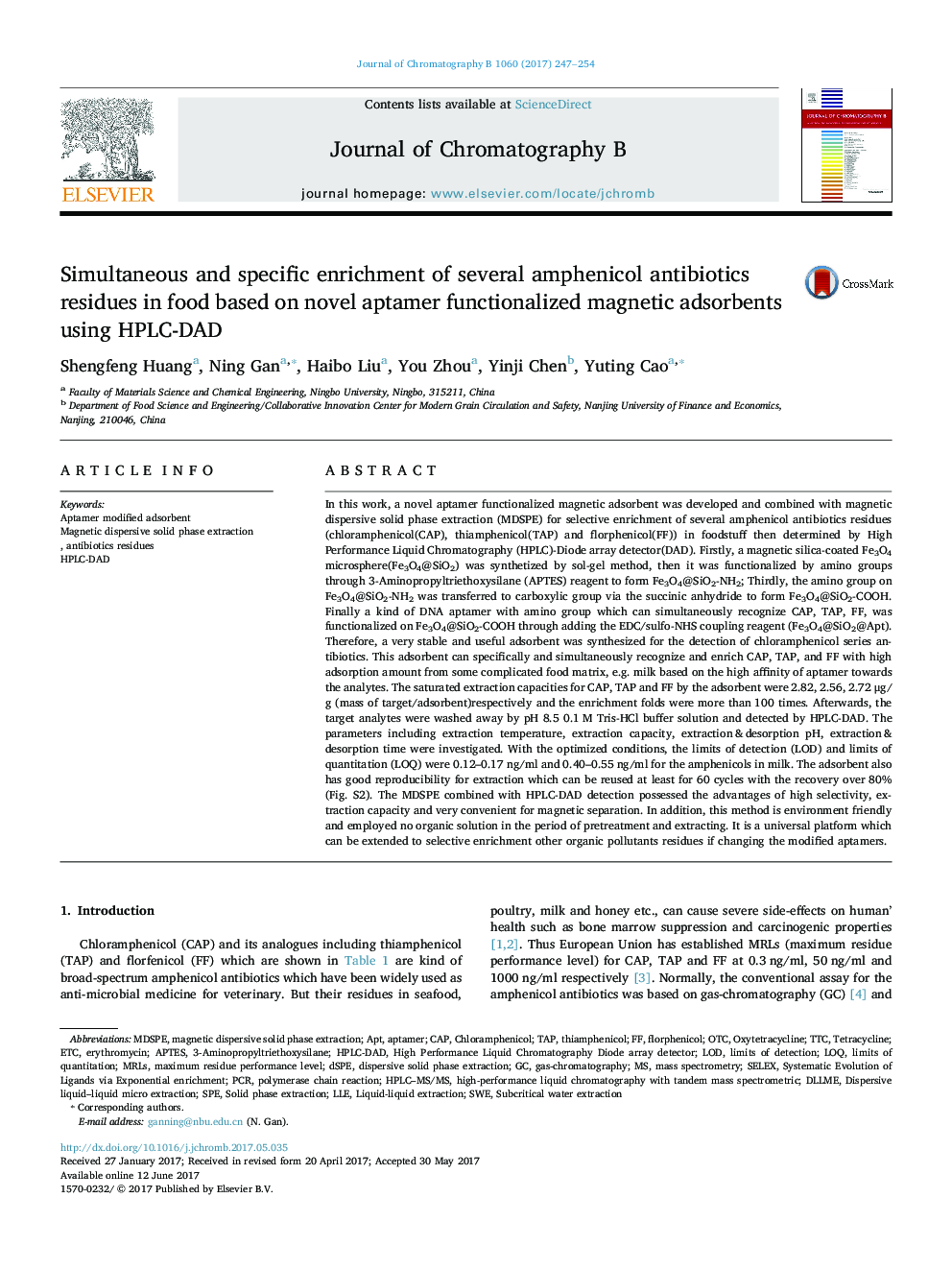| کد مقاله | کد نشریه | سال انتشار | مقاله انگلیسی | نسخه تمام متن |
|---|---|---|---|---|
| 5136417 | 1494003 | 2017 | 8 صفحه PDF | دانلود رایگان |

- A novel aptamer functionalized magnetic adsorbent was developed for selective enrichment of three amphenicols in complex food matrix.
- Dispersive solid phase extraction method coupling with the adsorbent was employed for detection 0.1Â ng/ml of amphenicols in milk.
- This assay is environmentally friendly and time-saving due to without using organic reagent and purifying.
In this work, a novel aptamer functionalized magnetic adsorbent was developed and combined with magnetic dispersive solid phase extraction (MDSPE) for selective enrichment of several amphenicol antibiotics residues (chloramphenicol(CAP), thiamphenicol(TAP) and florphenicol(FF)) in foodstuff then determined by High Performance Liquid Chromatography (HPLC)-Diode array detector(DAD). Firstly, a magnetic silica-coated Fe3O4 microsphere(Fe3O4@SiO2) was synthetized by sol-gel method, then it was functionalized by amino groups through 3-Aminopropyltriethoxysilane (APTES) reagent to form Fe3O4@SiO2-NH2; Thirdly, the amino group on Fe3O4@SiO2-NH2 was transferred to carboxylic group via the succinic anhydride to form Fe3O4@SiO2-COOH. Finally a kind of DNA aptamer with amino group which can simultaneously recognize CAP, TAP, FF, was functionalized on Fe3O4@SiO2-COOH through adding the EDC/sulfo-NHS coupling reagent (Fe3O4@SiO2@Apt). Therefore, a very stable and useful adsorbent was synthesized for the detection of chloramphenicol series antibiotics. This adsorbent can specifically and simultaneously recognize and enrich CAP, TAP, and FF with high adsorption amount from some complicated food matrix, e.g. milk based on the high affinity of aptamer towards the analytes. The saturated extraction capacities for CAP, TAP and FF by the adsorbent were 2.82, 2.56, 2.72 μg/g (mass of target/adsorbent)respectively and the enrichment folds were more than 100 times. Afterwards, the target analytes were washed away by pH 8.5 0.1 M Tris-HCl buffer solution and detected by HPLC-DAD. The parameters including extraction temperature, extraction capacity, extraction & desorption pH, extraction & desorption time were investigated. With the optimized conditions, the limits of detection (LOD) and limits of quantitation (LOQ) were 0.12-0.17 ng/ml and 0.40-0.55 ng/ml for the amphenicols in milk. The adsorbent also has good reproducibility for extraction which can be reused at least for 60 cycles with the recovery over 80% (Fig. S2). The MDSPE combined with HPLC-DAD detection possessed the advantages of high selectivity, extraction capacity and very convenient for magnetic separation. In addition, this method is environment friendly and employed no organic solution in the period of pretreatment and extracting. It is a universal platform which can be extended to selective enrichment other organic pollutants residues if changing the modified aptamers.
Journal: Journal of Chromatography B - Volume 1060, 15 August 2017, Pages 247-254